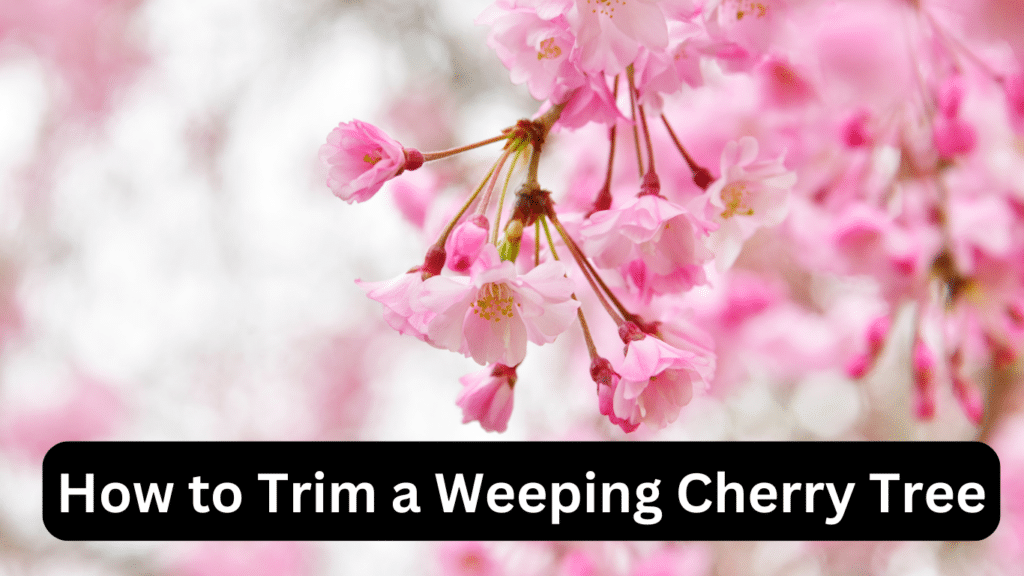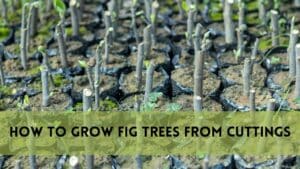Weeping cherry trees are renowned for their graceful, cascading branches and breathtaking blooms, making them a captivating addition to any landscape. Properly trimming these trees is essential to maintain their health, shape, and overall beauty. This comprehensive guide will walk you through the step-by-step process of trimming your weeping cherry tree, whether grafted or natural. You’ll learn the best techniques to prune for shaping and the ideal time to perform this task to ensure your tree thrives season after season.
Steps to Trim a Weeping Cherry Tree
Section I: Preparing for Pruning
- Identifying the Tree Type: Grafted or Natural Before you begin pruning, it’s crucial to determine whether your weeping cherry tree is grafted or natural. A grafted tree consists of two different plants joined together. The graft union is typically noticeable near the base of the tree, above the roots. On the other hand, a natural tree grows from a single root system without any grafting.
- Sanitizing Pruning Tools: To avoid transmitting diseases or infections to your weeping cherry tree, it’s essential to sanitize your pruning tools properly. Use rubbing alcohol to disinfect your tools before you start, ensuring a clean cut with minimal risk of introducing harmful pathogens.
Section II: Trimming a Grafted Weeping Cherry Tree
- Addressing Branches: Reaching the Ground Begin by focusing on the branches that touch the ground. Trim these branches lightly, cutting them back to approximately 6 inches above the ground level. This clearance prevents the branches from coming into contact with soil and reduces the risk of disease and pests.
- Tackling the Snarl of Branches in the Middle: Move on to the central area of the tree where multiple branches might intertwine. Carefully identify and remove any damaged, diseased, or crossing branches. If two branches are crossing, select the thinner one and make a clean cut at its base. This helps maintain a well-structured canopy and enhances air circulation within the tree.
- Maintaining the Weeping Shape: As you prune, focus on preserving the tree’s weeping form. Step back occasionally to assess the overall appearance and ensure you maintain the tree’s graceful silhouette. Trim any branches that disrupt the weeping effect, allowing the tree to retain its unique charm.
Section III: Trimming a Natural Weeping Cherry Tree
- Trimming Outer Branches: Touching the Ground For natural weeping cherry trees, follow a similar approach as with grafted trees. Trim the outer branches that touch the ground to a distance of about 6 inches above the ground level. This practice minimizes the risk of disease and enhances the tree’s aesthetic appeal.
- Addressing Damaged and Crossing Branches: Identify any branches that show signs of damage or disease and promptly remove them. Additionally, address crossing branches by cutting the thinner one at its base, promoting a healthy growth pattern.
- Maintaining the Weeping Shape: Just like with grafted trees, pay close attention to the tree’s overall weeping shape and make necessary adjustments. Trimming for shaping may be needed to preserve the tree’s beauty and form an umbrella-like canopy.
Section IV: Pruning for Shaping and Umbrella Form
- Trimming Branches to Fall Six Inches from the Ground: To maintain the desired height and shape of your weeping cherry tree, prune the branches to fall approximately six inches from the ground level. This height allows for proper air circulation and prevents the branches from trailing on the ground.
- Optional Pruning for Shaping: If you prefer a more tailored look, you can prune the branches even shorter to achieve your desired shape. However, be cautious not to over-prune, as this can stress the tree and hinder its growth.
- Tips for Maintaining an Umbrella Form: Regular maintenance is vital for preserving the classic umbrella-like form of weeping cherry trees. Regularly inspect the tree for damaged or misshapen branches and promptly trim them as needed. Additionally, consider hiring a professional arborist for periodic pruning to ensure the tree’s long-term health and beauty.
Section V: Best Time to Prune
- The Importance of Pruning During Dormancy: Pruning weeping cherry trees during their dormant period is critical for their well-being. The ideal time for pruning is late fall when the tree has shed its last flowers and leaves. During this time, the tree is less vulnerable to stress, and pruning promotes robust growth in the upcoming spring season.
Frequently Asked Questions
FAQ 1: What are the Common Mistakes to Avoid When Pruning a Weeping Cherry Tree?
Pruning a weeping cherry tree requires a delicate touch and proper technique to ensure the tree’s health and beauty. Avoiding these common mistakes will help you maintain a thriving weeping cherry tree:
- Over-Pruning: One of the most common mistakes is excessive pruning. Over-pruning can stress the tree and inhibit its growth and flowering potential. Always follow the recommended guidelines and refrain from removing too many branches at once.
- Incorrect Timing: Pruning at the wrong time can harm the tree. Avoid pruning during the growing season or when the tree is actively flowering. The best time to prune a weeping cherry tree is during its dormant period, typically in late fall after the leaves and flowers have fallen.
- Neglecting Sanitation: Please sanitize your pruning tools to avoid the transmission of diseases and pests. Before starting, clean your tools with rubbing alcohol to ensure a clean cut and prevent infections.
- Improper Cuts: Making incorrect cuts can damage the tree and compromise its natural shape. Always use sharp, clean pruning shears and make clean, angled cuts just above a node or bud.
- Neglecting Diseased Branches: If you notice any diseased or damaged branches, remove them promptly. Ignoring such branches can spread diseases to other parts of the tree and affect its overall health.
FAQ 2: What Tools are Needed to Prune a Weeping Cherry Tree?
To successfully prune a weeping cherry tree, you’ll need the following tools:
- Pruning Shears: Use sharp pruning shears for cutting small branches and stems. Look for bypass pruners that make clean, precise cuts without crushing the branches.
- Loppers: For thicker branches, loppers come in handy. These long-handled pruning tools provide the leverage needed to cut through larger branches effectively.
- Hand Saw: A hand saw is essential for cutting branches that are too thick for loppers. Choose a saw with fine teeth for smooth cuts.
- Rubbing Alcohol: Sanitizing your tools before and after pruning is crucial to preventing disease spread. Keep a bottle of rubbing alcohol on hand for this purpose.
- Safety Gear: Wear gloves and goggles to protect your hands and eyes while pruning. If you plan to use a ladder, make sure it’s stable and secure.
FAQ 3: When is the Best Time to Prune a Weeping Cherry Tree?
The best time to prune a weeping cherry tree is during its dormant period, typically in late fall or winter. Pruning during this time when the tree is not actively growing, or flowering reduces the stress on the tree and promotes healthy regrowth in the spring.
FAQ 4: How Do You Treat a Weeping Cherry Tree?
Treating a weeping cherry tree involves proper care and maintenance to ensure its well-being:
- Watering: Provide adequate water during dry spells, especially for young trees. Proper hydration helps the tree establish solid roots and withstand stress.
- Fertilizing: Apply a balanced fertilizer in early spring to provide essential nutrients for healthy growth and vibrant blooms.
- Pruning: Follow the guidelines mentioned earlier in this guide to shape the tree, remove deadwood, and improve its overall health.
- Mulching: Apply a layer of organic mulch around the tree’s base to retain moisture, suppress weeds, and maintain a consistent soil temperature.
- Pest and Disease Control: Regularly inspect the tree for pests and signs of disease. Address any issues promptly to prevent further damage.
FAQ 5: What’s Wrong with My Weeping Cherry Tree?
If your weeping cherry tree exhibits any of the following signs, it might indicate a problem:
- Wilting Leaves: Wilting or yellowing leaves could be a sign of overwatering, underwatering, or a root issue.
- Brown Spots on Leaves: Brown spots or lesions on leaves may indicate a fungal infection.
- Premature Leaf Drop: If the tree is losing leaves prematurely, it could be due to stress, disease, or environmental factors.
- Lack of Blooms: A weeping cherry tree not producing flowers might result from insufficient sunlight, pruning at the wrong time, or nutrient deficiencies.
- Presence of Pests: Insects or pests feeding on the leaves or branches can cause damage to the tree.
To identify the specific issue and find the appropriate solution, consider consulting with a professional arborist or a local horticulturist who can diagnose the problem and recommend the necessary steps to remedy it.
Conclusion
Trimming a weeping cherry tree might seem daunting, but with the proper knowledge and techniques, it becomes a rewarding and beneficial endeavour. Remember to identify your tree type, sanitize your tools, and follow the step-by-step guidelines for grafted and natural trees. By pruning for shaping and maintaining an umbrella form, you’ll ensure your weeping cherry tree remains a breathtaking centrepiece in your garden for years to come.





